Abstract
Recent investigations on mechanism of carcinogenesis have demonstrated important quantitative relationships between the induction of neoplasia, the molecular dose of promutagenic DNA adducts and their efficiency for causing base-pair mismatch, and the extent of cell proliferation in target organ. These factors are involved in the multistage process of carcinogenesis, including initiation, promotion, and progression. The molecular dose of DNA adducts can exhibit supralinear, linear, or sublinear relationships to external dose due to differences in absorption, biotransformation, and DNA repair at high versus low doses. In contrast, increased cell proliferation is a common phenomena that is associated with exposures to relatively high doses of toxic chemicals. As such, it enhances the carcinogenic response at high doses, but has little effect at low doses. Since data on cell proliferation can be obtained for any exposure scenario and molecular dosimetry studies are beginning to emerge on selected chemical carcinogens, methods are needed so that these critical factors can be utilized in extrapolation from high to low doses and across species. The use of such information may provide a scientific basis for quantitative risk assessment.
Full text
PDF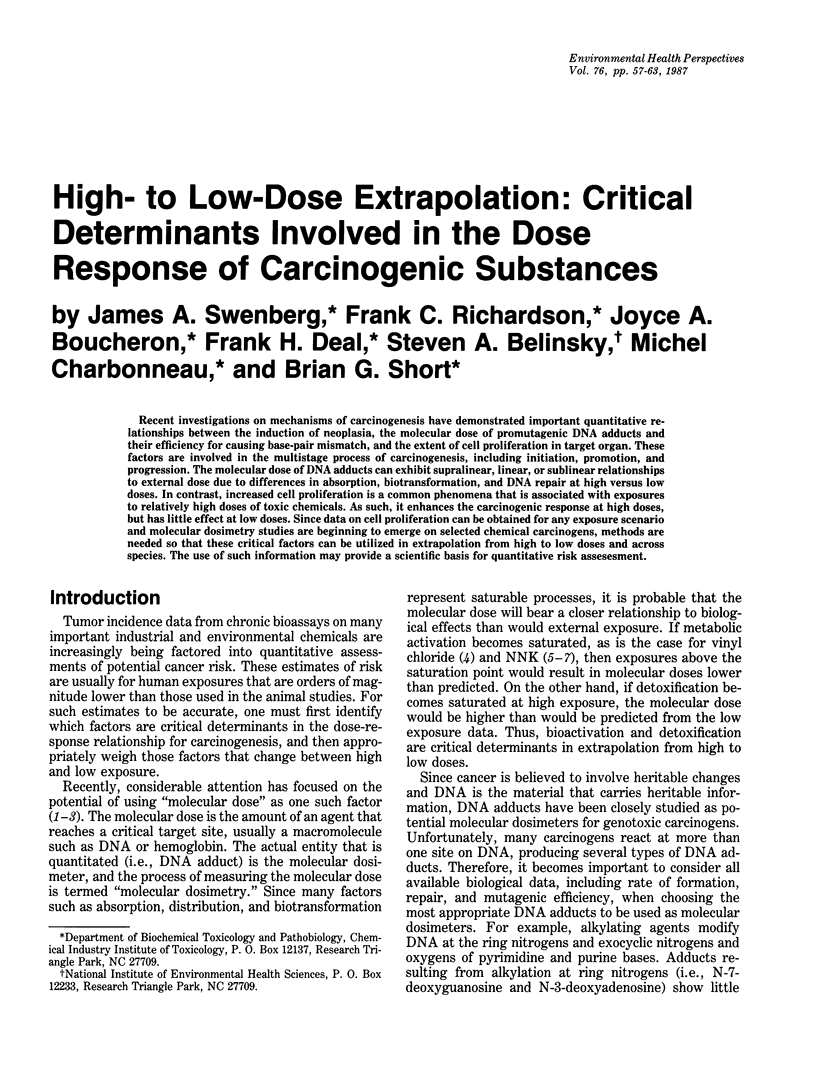
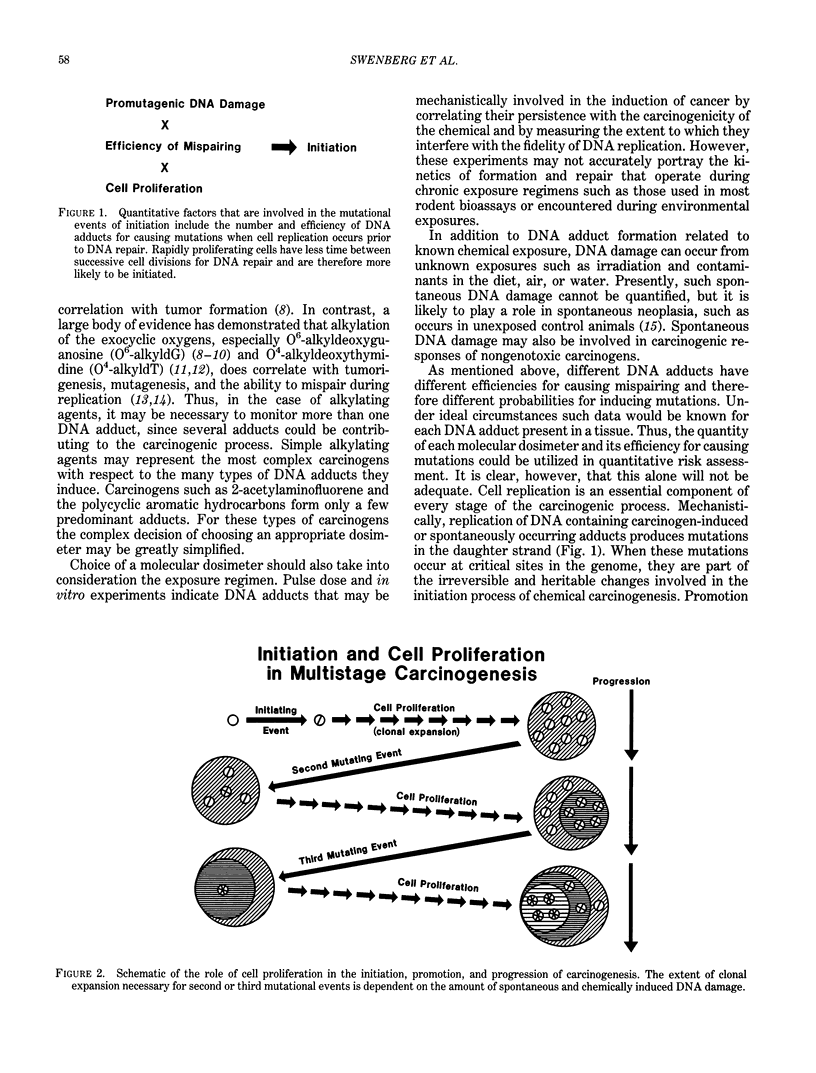
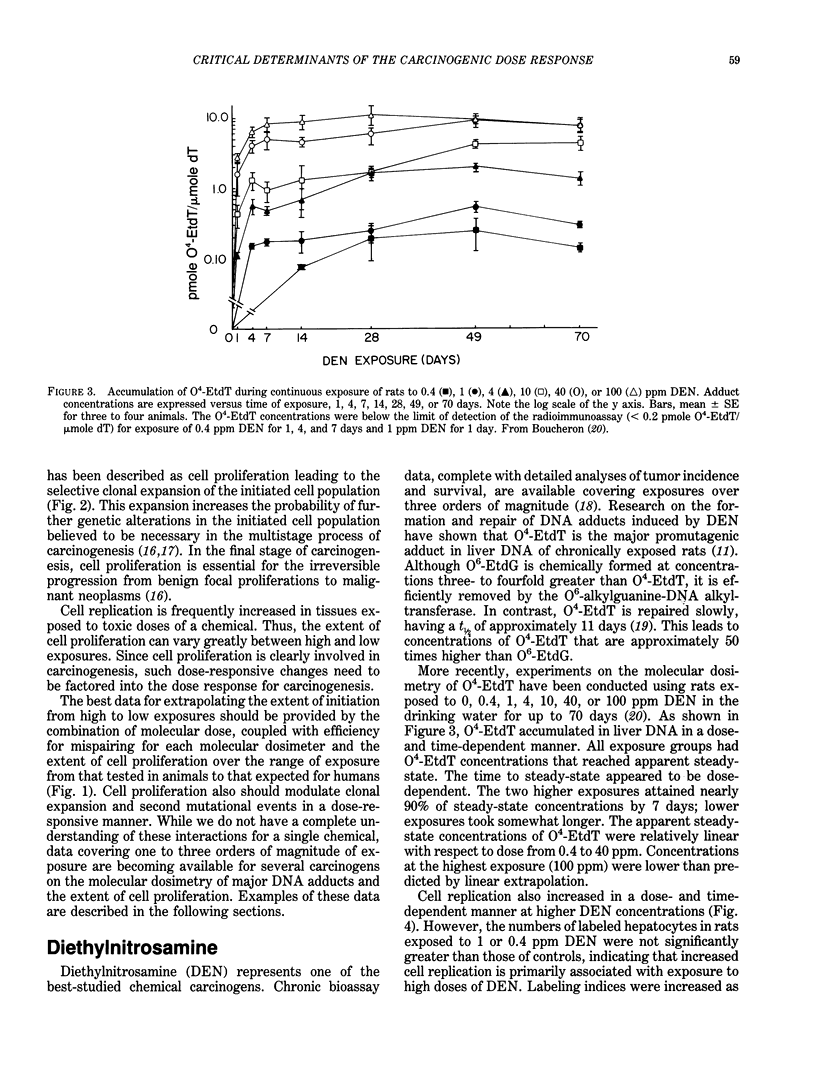
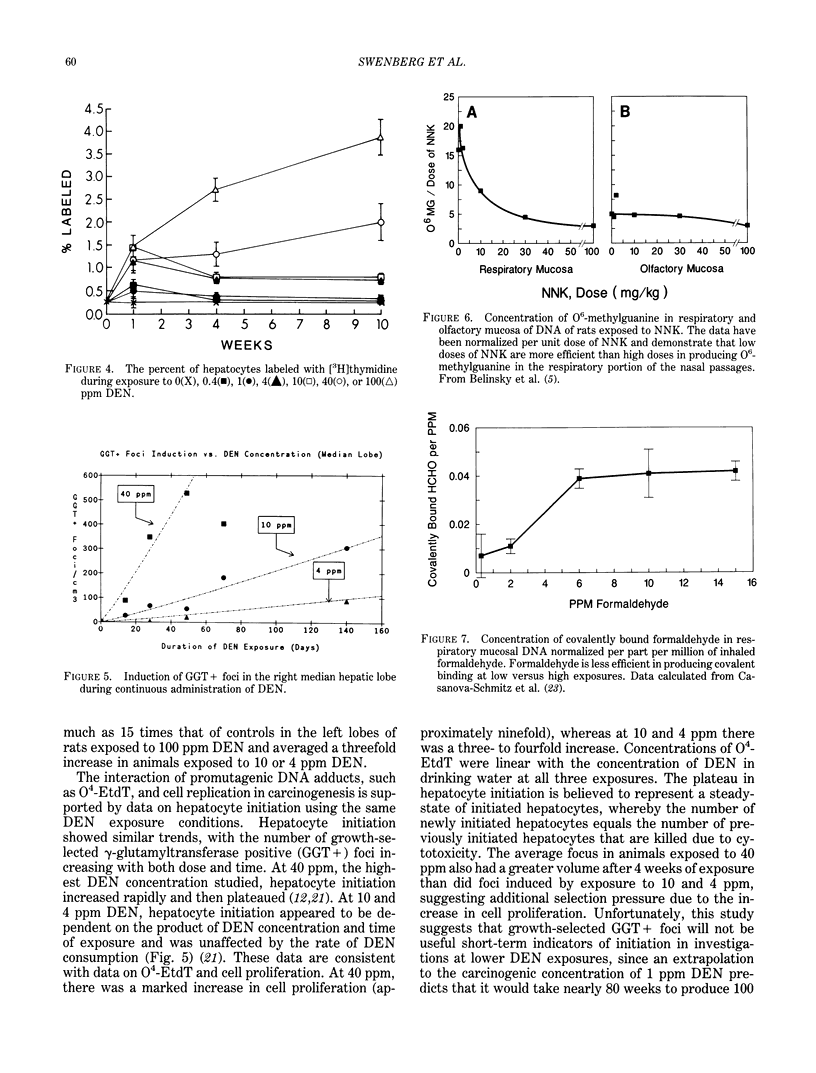
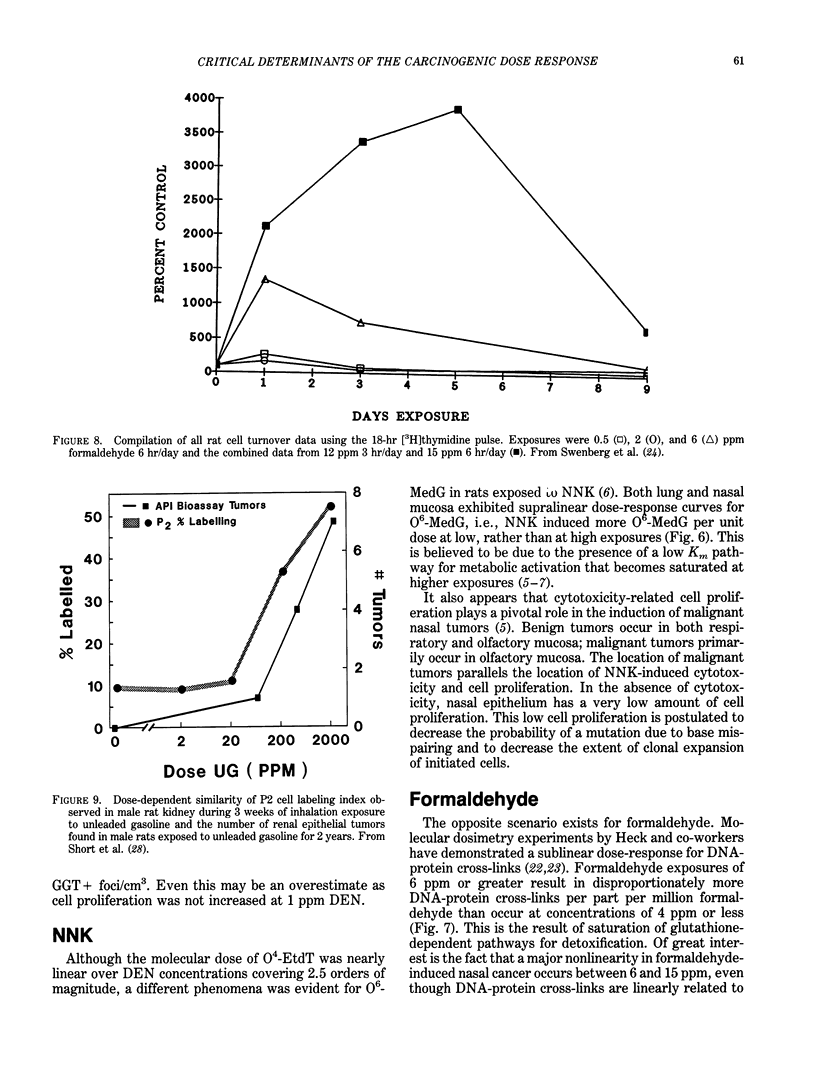
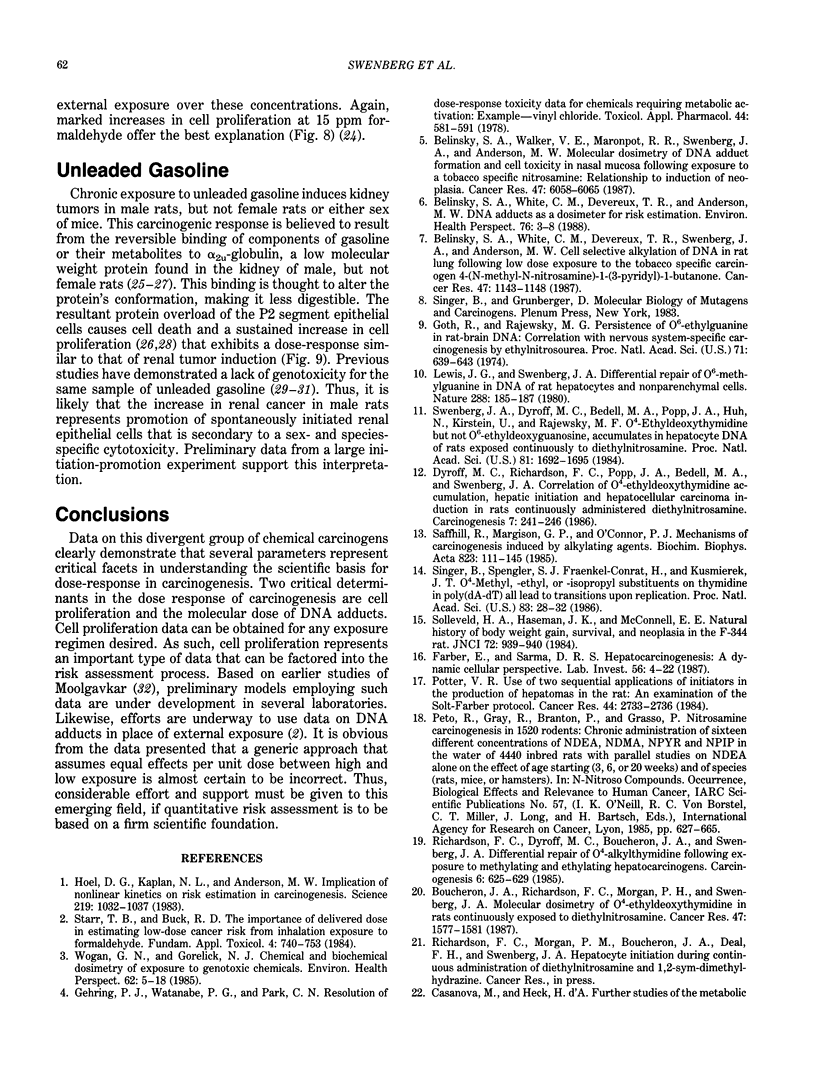
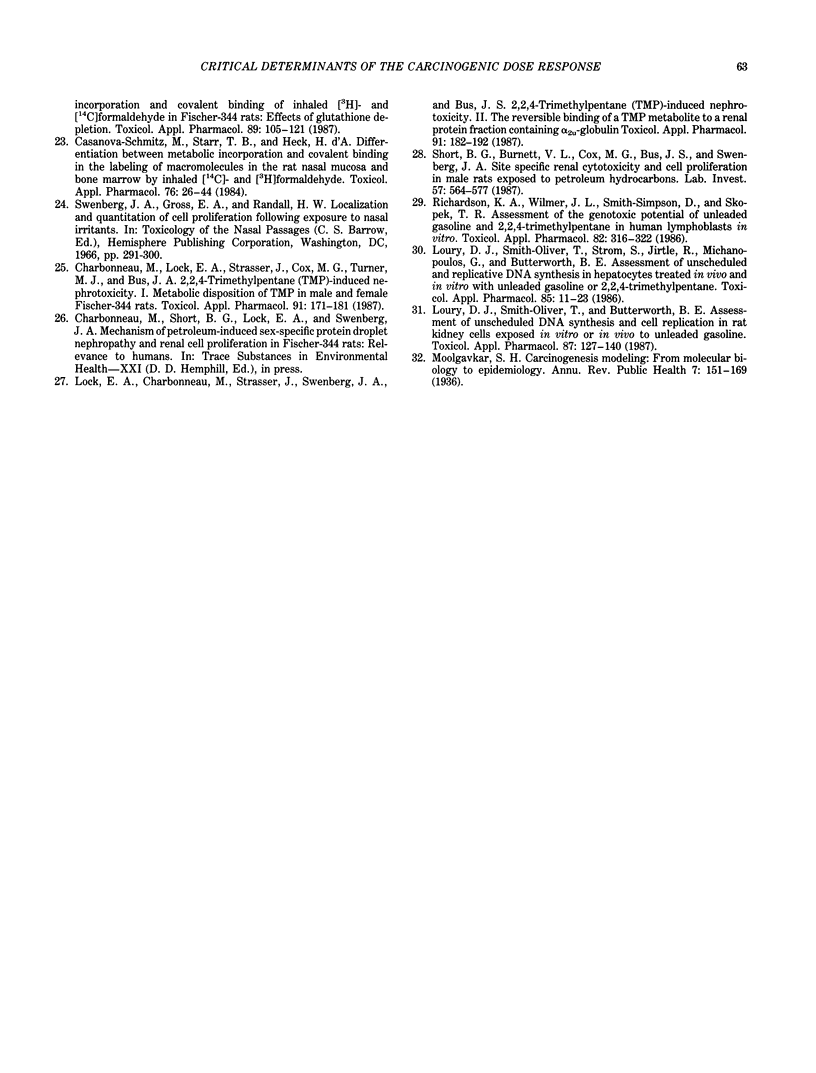
Selected References
These references are in PubMed. This may not be the complete list of references from this article.
- Belinsky S. A., Walker V. E., Maronpot R. R., Swenberg J. A., Anderson M. W. Molecular dosimetry of DNA adduct formation and cell toxicity in rat nasal mucosa following exposure to the tobacco specific nitrosamine 4-(N-methyl-N-nitrosamino)-1-(3-pyridyl)-1-butanone and their relationship to induction of neoplasia. Cancer Res. 1987 Nov 15;47(22):6058–6065. [PubMed] [Google Scholar]
- Belinsky S. A., White C. M., Devereux T. R., Anderson M. W. DNA adducts as a dosimeter for risk estimation. Environ Health Perspect. 1987 Dec;76:3–8. doi: 10.1289/ehp.87763. [DOI] [PMC free article] [PubMed] [Google Scholar]
- Belinsky S. A., White C. M., Devereux T. R., Swenberg J. A., Anderson M. W. Cell selective alkylation of DNA in rat lung following low dose exposure to the tobacco specific carcinogen 4-(N-methyl-N-nitrosamino)-1-(3-pyridyl)-1-butanone. Cancer Res. 1987 Feb 15;47(4):1143–1148. [PubMed] [Google Scholar]
- Boucheron J. A., Richardson F. C., Morgan P. H., Swenberg J. A. Molecular dosimetry of O4-ethyldeoxythymidine in rats continuously exposed to diethylnitrosamine. Cancer Res. 1987 Mar 15;47(6):1577–1581. [PubMed] [Google Scholar]
- Casanova-Schmitz M., Starr T. B., Heck H. D. Differentiation between metabolic incorporation and covalent binding in the labeling of macromolecules in the rat nasal mucosa and bone marrow by inhaled [14C]- and [3H]formaldehyde. Toxicol Appl Pharmacol. 1984 Oct;76(1):26–44. doi: 10.1016/0041-008x(84)90026-7. [DOI] [PubMed] [Google Scholar]
- Charbonneau M., Lock E. A., Strasser J., Cox M. G., Turner M. J., Bus J. S. 2,2,4-Trimethylpentane-induced nephrotoxicity. I. Metabolic disposition of TMP in male and female Fischer 344 rats. Toxicol Appl Pharmacol. 1987 Nov;91(2):171–181. doi: 10.1016/0041-008x(87)90098-6. [DOI] [PubMed] [Google Scholar]
- Dyroff M. C., Richardson F. C., Popp J. A., Bedell M. A., Swenberg J. A. Correlation of O4-ethyldeoxythymidine accumulation, hepatic initiation and hepatocellular carcinoma induction in rats continuously administered diethylnitrosamine. Carcinogenesis. 1986 Feb;7(2):241–246. doi: 10.1093/carcin/7.2.241. [DOI] [PubMed] [Google Scholar]
- Farber E., Sarma D. S. Hepatocarcinogenesis: a dynamic cellular perspective. Lab Invest. 1987 Jan;56(1):4–22. [PubMed] [Google Scholar]
- Gehring P. J., Watanabe P. G., Park C. N. Resolution of dose-response toxicity data for chemicals requiring metabolic activation: example--vinyl chloride. Toxicol Appl Pharmacol. 1978 Jun;44(3):581–591. doi: 10.1016/0041-008x(78)90266-1. [DOI] [PubMed] [Google Scholar]
- Goth R., Rajewsky M. F. Persistence of O6-ethylguanine in rat-brain DNA: correlation with nervous system-specific carcinogenesis by ethylnitrosourea. Proc Natl Acad Sci U S A. 1974 Mar;71(3):639–643. doi: 10.1073/pnas.71.3.639. [DOI] [PMC free article] [PubMed] [Google Scholar]
- Hoel D. G., Kaplan N. L., Anderson M. W. Implication of nonlinear kinetics on risk estimation in carcinogenesis. Science. 1983 Mar 4;219(4588):1032–1037. doi: 10.1126/science.6823565. [DOI] [PubMed] [Google Scholar]
- Lewis J. G., Swenberg J. A. Differential repair of O(6)-methylguanine in DNA of rat hepatocytes and nonparenchymal cells. Nature. 1980 Nov 13;288(5787):185–141. doi: 10.1038/288185a0. [DOI] [PubMed] [Google Scholar]
- Lock E. A., Charbonneau M., Strasser J., Swenberg J. A., Bus J. S. 2,2,4-Trimethylpentane-induced nephrotoxicity. II. The reversible binding of a TMP metabolite to a renal protein fraction containing alpha 2u-globulin. Toxicol Appl Pharmacol. 1987 Nov;91(2):182–192. doi: 10.1016/0041-008x(87)90099-8. [DOI] [PubMed] [Google Scholar]
- Loury D. J., Smith-Oliver T., Butterworth B. E. Assessment of unscheduled and replicative DNA synthesis in rat kidney cells exposed in vitro or in vivo to unleaded gasoline. Toxicol Appl Pharmacol. 1987 Jan;87(1):127–140. doi: 10.1016/0041-008x(87)90091-3. [DOI] [PubMed] [Google Scholar]
- Loury D. J., Smith-Oliver T., Strom S., Jirtle R., Michalopoulos G., Butterworth B. E. Assessment of unscheduled and replicative DNA synthesis in hepatocytes treated in vivo and in vitro with unleaded gasoline or 2,2,4-trimethylpentane. Toxicol Appl Pharmacol. 1986 Aug;85(1):11–23. doi: 10.1016/0041-008x(86)90383-2. [DOI] [PubMed] [Google Scholar]
- Moolgavkar S. H. Carcinogenesis modeling: from molecular biology to epidemiology. Annu Rev Public Health. 1986;7:151–169. doi: 10.1146/annurev.pu.07.050186.001055. [DOI] [PubMed] [Google Scholar]
- Potter V. R. Use of two sequential applications of initiators in the production of hepatomas in the rat: an examination of the Solt-Farber protocol. Cancer Res. 1984 Jun;44(6):2733–2736. [PubMed] [Google Scholar]
- Richardson F. C., Dyroff M. C., Boucheron J. A., Swenberg J. A. Differential repair of O4-alkylthymidine following exposure to methylating and ethylating hepatocarcinogens. Carcinogenesis. 1985 Apr;6(4):625–629. doi: 10.1093/carcin/6.4.625. [DOI] [PubMed] [Google Scholar]
- Richardson K. A., Wilmer J. L., Smith-Simpson D., Skopek T. R. Assessment of the genotoxic potential of unleaded gasoline and 2,2,4-trimethylpentane in human lymphoblasts in vitro. Toxicol Appl Pharmacol. 1986 Feb;82(2):316–322. doi: 10.1016/0041-008x(86)90207-3. [DOI] [PubMed] [Google Scholar]
- Saffhill R., Margison G. P., O'Connor P. J. Mechanisms of carcinogenesis induced by alkylating agents. Biochim Biophys Acta. 1985 Dec 17;823(2):111–145. doi: 10.1016/0304-419x(85)90009-5. [DOI] [PubMed] [Google Scholar]
- Short B. G., Burnett V. L., Cox M. G., Bus J. S., Swenberg J. A. Site-specific renal cytotoxicity and cell proliferation in male rats exposed to petroleum hydrocarbons. Lab Invest. 1987 Nov;57(5):564–577. [PubMed] [Google Scholar]
- Singer B., Spengler S. J., Fraenkel-Conrat H., Kuśmierek J. T. O4-Methyl, -ethyl, or -isopropyl substituents on thymidine in poly(dA-dT) all lead to transitions upon replication. Proc Natl Acad Sci U S A. 1986 Jan;83(1):28–32. doi: 10.1073/pnas.83.1.28. [DOI] [PMC free article] [PubMed] [Google Scholar]
- Starr T. B., Buck R. D. The importance of delivered dose in estimating low-dose cancer risk from inhalation exposure to formaldehyde. Fundam Appl Toxicol. 1984 Oct;4(5):740–753. doi: 10.1016/0272-0590(84)90095-2. [DOI] [PubMed] [Google Scholar]
- Swenberg J. A., Dyroff M. C., Bedell M. A., Popp J. A., Huh N., Kirstein U., Rajewsky M. F. O4-ethyldeoxythymidine, but not O6-ethyldeoxyguanosine, accumulates in hepatocyte DNA of rats exposed continuously to diethylnitrosamine. Proc Natl Acad Sci U S A. 1984 Mar;81(6):1692–1695. doi: 10.1073/pnas.81.6.1692. [DOI] [PMC free article] [PubMed] [Google Scholar]
- Wogan G. N., Gorelick N. J. Chemical and biochemical dosimetry of exposure to genotoxic chemicals. Environ Health Perspect. 1985 Oct;62:5–18. doi: 10.1289/ehp.85625. [DOI] [PMC free article] [PubMed] [Google Scholar]


